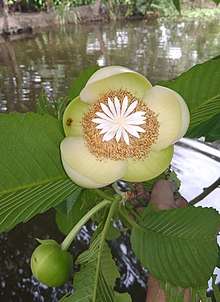Dillenia indica
| Dillenia indica | |
|---|---|
 | |
 | |
| Leaves, fruits & buds in West Bengal, India | |
| Scientific classification | |
| Kingdom: | Plantae |
| Clade: | Angiosperms |
| Clade: | Eudicots |
| Order: | Dilleniales |
| Family: | Dilleniaceae |
| Genus: | Dillenia |
| Species: | D. indica |
| Binomial name | |
| Dillenia indica | |
Dillenia indica, commonly known as elephant apple[1] or chulta,[2] is a species of Dillenia native to southeastern Asia, from India, Bangladesh and Sri Lanka east to southwestern China (Yunnan) and Vietnam, and south through Thailand to Malaysia and Indonesia.[1]
Description
It is an evergreen large shrub or small to medium-sized tree growing to 15 m tall. The leaves are 15–36 cm long, with a conspicuously corrugated surface with impressed veins. Its branches are used to make good firewood. The flowers are large, 15–20 cm diameter, with five white petals and numerous yellow stamens. Its characteristic round fruits are large, greenish yellow, have many seeds and are edible. The fruit is a 5–12 cm diameter aggregate of 15 carpels, each carpel containing five seeds embedded in an edible but fibrous pulp.[3][4]
Taxonomy
Dillenia indica was one of the many species first described by Linnaeus in the 10th edition of his Systema Naturae in 1759.[5]
Ecology
Dillenia indica produces a large hard fruit which is accessible only to the megaherbivores. An interesting study in the Buxa Tiger Reserve by ecologists Sekar & Sukumar has shown that Asian elephants appear to have a particular fondness for the fruits of D. indica, and hence an important seed dispenser for this tree. With the prospects of extinction of the elephants this tree has developed a back-up system, whereby its hard fruits that were only accessible to megaherbivores, slowly soften on the forest floor through the dry season to allow access to successively smaller animals such as macaques, rodents and squirrels. Seeds from both old and soft fruits are able to germinate well, enabling the persistence of this tree to be independent of the survival of its major megaherbivore disperser.[6]
Uses
The fruit pulp is sour and used in Indian cuisine in curries, jam (ouu khatta), and jellies.[3] It is often mixed with coconut and spices to make chutneys. It is called ঔ টেঙা and extensively used in Dal and fish curry in Assam.
In India, it is not commercially cultivated, but is found wild in the Terai & Dooars region and Katha Reserve Forest (RF), Burihiding RF, Duarmara RF, Tarani RF, Dumduma RF, Nalni RF, Philobari RF, Takowani RF, Kakojan RF, Digboi RF, Bogapani RF and Upper Dihing RF[(upper assam area)]. Because it is a main source of food for elephants, monkeys and deer, collection of fruit from the core areas of the forest are prohibited. Commercial sale of the fruit is also prohibited in an effort to help the food-chain system of the forest from dismantling totally.[7] However no law has been implemented so far.
References
- 1 2 "Dillenia indica". Germplasm Resources Information Network (GRIN). Agricultural Research Service (ARS), United States Department of Agriculture (USDA).
- ↑ "Dillenia indica". Natural Resources Conservation Service PLANTS Database. USDA. Retrieved 21 Sep 2016.
- 1 2 Huxley, A., ed. (1992). New RHS Dictionary of Gardening. Macmillan ISBN 0-333-47494-5.
- ↑ Flora of Pakistan: Dillenia indica
- ↑ Linnaeus, Carl (1758). Systema Naturae per Regna Tria Naturae, Secundum Classes, Ordines, Genera, Species, cum Characteribus, Differentiis, Synonymis, Locis (in Latin). Vol. 2 (10th revised ed.). Holmiae: (Laurentii Salvii). p. 1082.
- ↑ Sekar, Nitin; Sukumar, Raman; Leishman, Michelle (2013). "Waiting for Gajah: an elephant mutualist's contingency plan for an endangered megafaunal disperser". Journal of Ecology. 101 (6): 1379–88. doi:10.1111/1365-2745.12157.
- ↑ Sumanta Ray Chaudhuri (21 June 2007). "Elephants and villagers fight over pickle fruit". DNA.